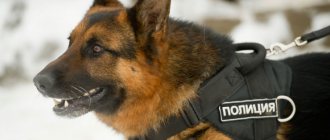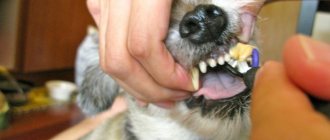Often, pet owners are faced with a situation where the animal does not react at all to a stranger. It is undoubtedly good when it is possible to live in an apartment. But if you are the owner of a large private house, such a dog will not be a guard or assistant. In this situation, the animal must be taught to react to strangers. Many people ask: “How to make a dog angry at strangers?” Of course, the best way is to contact a trainer, but this is not always possible. In this article we will look at different options.
Building the right relationship with your dog
If you have a question about how to make a dog angry at strangers, you must first understand the essence of the animal. Dogs of any breed are designed in such a way that their owner is their best friend and comrade. Protecting it is their natural feature, which is inherent at the genetic level.
You should not raise a dog aggressively, beat it, scare it just to develop anger in it. On the contrary, affection, love, understanding will help you raise real defenders of your home.
Experienced dog handlers can tell you how to make a dog angry at strangers; for this you need to take special training courses. Similar clubs are located in every major city. Therefore, if a pet is new to your family, it is better to seek advice from a dog breeder.
Who is the head in this house
Before you begin training with a German Shepherd, you need to learn the basics of its psychology. Dogs are pack creatures, they have a leader. In a home environment, this position should be taken by the owner. A leadership position does not imply cruelty, but requires obedience. What does it mean? Any dog, especially a guard dog, will try to dominate its owner even in a game:
- snatch the toy from his hands;
- put your paw on it like a master;
- to get ahead on a walk, “leading the owner.”
A guard dog should not be allowed to do this. You will have to patiently wean your pet off being “above the owner.”
In order to control your dog, you yourself must be in a calm and confident state, since the animal is sensitive to the mood of the owner.
When you pick up the leash, you should feel calm and confident: this is the most important factor in controlling a dog.
By sensing your strong energy, the dog will be more manageable. Conversely, when you are irritated or angry, the animal will act nervous or fearful.
How to teach commands correctly?
So, before you start training a dog with the “Stranger!” command, it is necessary that it knows and follows other basic orders: “Sit!”, “Lie down!” and others. It is better for a dog handler to do this, but if it happens that there is no opportunity to visit the club, you need to know and follow the basic rules:
- First of all, tell your friends, acquaintances, and neighbors to stop petting and playing with your animal. Ideally, they should not communicate with him at all.
- If a dog wags its tail and squeals when meeting a stranger, the best way is to call it by name and quickly walk away in the opposite direction. Remember, the owner is the authority for the dog. She will certainly forget about strangers and follow her owner.
- Any dog breeder will tell you that you can’t do without an irritant. To do this, purchase a special protective suit and ask your friends to swing at you or the dog. The reaction will follow immediately. But it is worth remembering that such an experiment is absolutely not safe.
- Always reward your pet after training sessions.
After reading the above rules, you will be able to answer the question of how to make a dog angry at strangers at home. The main thing is not to overdo it with training and not to turn your pet against yourself and your family.
Secrets of proper training
Training a four-legged prankster is a rather difficult process that requires attention and patience from the owner. It is better to achieve what you want with the help of persuasion and bait, completely avoiding physical coercion or violence. You cannot raise your voice or shout, so as not to frighten the dog; negative words should be replaced with softer ones. For example, if your pet does something wrong, you shouldn’t say “Bad!”, it’s better to say “Oh!” or something similar. The dog must be trained by the same person - either a family member or a specially invited specialist.
One of the main conditions for successful training is the ability to stop in time, giving the dog a rest. The pet should perceive the entire process as a game, and not a grueling chanting of commands. For every success, even a small one, the dog should be praised, combining stroking and a tasty treat. In this way, the owner will establish a strong connection between himself and the pet and establish a high level of mutual respect. Having learned several commands, do not forget to repeat them constantly - this is an excellent help for new tricks.
Watch your dog closely: if he is hesitant to follow commands, he may be afraid of you or your judgement. Bring more love and affection into your animal's activities and daily life, making him more trusting and open.
At what age should I start?
There are two stages of training your beloved pet: at the age of 1 to 3 months and from 4 months onwards. First, the puppy needs to be taught to follow simple commands - to develop an instinct of obedience to the owner. The simplest of them: response to a nickname, accustoming to an individual place, prohibiting words, the command “give”. It is much more difficult to train an adult dog that has not undergone preliminary training, but the task is quite achievable. Regardless of the duration of training, you can begin training to protect yourself from strangers only after achieving complete mutual understanding and obedience of your pet.
Breeds that are easy to train:
- Border Collie;
- German Shepherd;
- Retriever;
- Poodle;
- Rottweiler;
- Sheltie.
Difficult to train:
- Afghan Hound;
- Chow-chow;
- Bulldog.
Some useful tips for pet owners
When understanding the issue of training, you need to know several important points and strictly observe them:
- All dogs, without exception, begin to bark or squeal when a stranger appears. At this moment, loudly say the phrase “Guard!” or any other word that you choose for the command, and reward the animal with affection or tasty treats.
- The main thing is not to scare the puppy, so that in the future he does not react to strangers with fear, for example, by huddling under the table.
- Do not yell at your pet, and especially do not use aggressive methods.
- After teaching your dog to vocalize, don’t forget about the “Fu!” command. Otherwise, the animal may bark for hours.
- Never hit an animal; these methods are unacceptable for the owner.
Many people ask the question: “How to make a dog angry at strangers (shepherd, pit bull, boxer)?” After all, these breeds are a priori fighting ones. You need to act with them in the same way as with dogs of other, calmer breeds. But mistakes cannot be made, otherwise the situation may get out of control.
Types of aggression and ways to correct them
There are 10 main types of behavior caused by anger. Each of them has characteristic features and requires special correction methods.
Dominant
It appears during puberty and social maturation - at 1.5 - 3 years. More typical for males. Only 10% of bitches exhibit it. A characteristic sign is that the dog becomes even more embittered when punished.
How to prevent and correct:
- establish a clear hierarchy in the family, in which the dog will take last place;
- determine the rules of behavior for the dog and strictly adhere to them;
- prohibit the pet from sleeping on the bed or eating from the table;
- ensure that the animal obeys the first time, or at most the second time.
Food
Easily identified by the following characteristics:
- when eating, the dog bares its teeth at suitable dogs, cats, people;
- bites when trying to pick up a bowl;
- at the same time growls and greedily swallows food, and may drop it;
- Sometimes attacks of food aggression occur if the dog receives a special treat.
It develops quite often due to indulgence in food habits: feeding from the table, frequent undeserved treats, encouragement of begging. Also, food aggression appears if the animal eats before or at the same time as family members.
How to wean:
- before feeding, give the command “sit”;
- place the bowl in front of the dog and command “wait”;
- pause and allow eating with the command “may”;
- interrupt the meal with the commands “fu”, “no”, “wait”, wait a little and allow eating again;
- repeat several times.
Protection from yard dogs
Owners of four-legged friends are also interested in the question of how to make a dog angry at other people's dogs. After all, while walking in parks, you can meet flocks of stray animals. Remember, a pack will never attack a person if there is a dog next to him.
The main thing is not to get confused at this moment, assess the situation and clearly say the command: “Face!” The animal will burst into loud barking, after which the dogs should run away.
It is inhumane to deliberately set animals against each other. Also remember that stray dogs may have rabies.
If after reading the article you still have a question: “How to make a dog angry at strangers?” — it’s better to contact an experienced dog handler for an answer. He will help you raise the animal correctly.
What do you prefer to feed your pets?
- Porridge with various additives 46%, 8371 votes
Dry food only 26%, 4711 votes
Exclusively meat 13%, 2464 votes
I buy special canned food 7%, 1233 votes
Special veterinary feeds 5%, 986 votes
I don't feed her, she finds food somewhere herself 3%, 575 votes
January 17, 2018
Poll Options are limited because JavaScript is disabled in your browser.
Of course, decorative dogs are not bought to protect the house, but for the soul. But why not combine business with pleasure and use the innate abilities of dogs given to them, regardless of the size and characteristics of the breed? Of course, a toy terrier may not be able to detain a burglar, but with their loud barking they are able to raise the alarm and even scare off an intruder who does not count on the presence of a dog in the house.
A dog distinguishes its own from strangers by many signs that often go unnoticed by us. It analyzes smells, voices, and sounds made by people when they move and touch doors. Moreover, a four-legged friend can sense the approach of familiar people from afar and will rarely bark at them. We are talking not only about family members, but also about friends who are often in the house.
Larger dogs are trained not only to signal when a stranger tries to open the door, but also to resist. The role of small animals is to serve as living alarms.
Bow
A body position that pets often adopt on their own when stretching or playing with their relatives. The dog that follows the command stands on its hind legs and lies on its front legs. The starting position is at the left foot. We step on the leash with our left foot, and with our right hand we move the treats away from the nose, forward and down. We provoke the pet to lie down without giving the command “Lie down”. As soon as the ward begins to stretch out his front paws, we put our left hand under the stomach, restraining the reflex forward movement, and give the command “Bow.” At the initial stage, even a slight tilt of the dog’s body is considered successful execution of the command.
The problem of hidden evidence.
The author of this term, mathematician, philosopher and successful trader, Nassim Nicholas Taleb.
In his magnificent book “The Black Swan”, he, citing Cicero, gives the following story.
“The Greek philosopher Diagoras, nicknamed the Atheist, was shown images of people who prayed to the gods and were saved from a shipwreck. It was understood that prayer saves from death. Diagoras asked: “Where are the images of those who prayed, but still drowned?” It is not so easy for pious drowned men to express their opinions from the bottom of the sea for the reason that they are dead.”
Next, he cites the opinion of Michel de Montaigne and Francis Bacon, who saw in this story an example of the origin of all superstitions. In particular, Bacon wrote: “This is the basis of almost all superstitions - in astrology, in dreams, in superstitions, in predictions and the like.”
The book is wonderful and I recommend reading it to everyone who wants to understand the nature and role of chance in our lives.
I hope that you understand that by quoting these excerpts from Nassim Taleb’s book “Black Swan”, I want to say that belief in “dogs that unconditionally love people” is akin to the superstition of our days. And that by starting a conversation about aggressive dogs, we touch on the problem of hidden evidence - we do not know how many dogs actually attack people, because their owners prefer to remain silent, feeling condemned by society.
If dogs with hereditary aggression regularly appear, and the owner is not really to blame for this, then who is to blame for this? Let's figure it out.
What do you need to know before training?
Before you develop the skill of barking on command in your puppy, you need to decide on the type of his temperament. Dogs, like people, have their own character and are divided into the same psychotypes.
Choleric
Such a puppy is active, does not leave a single step from the owner and is interested in everything in the world. He may even forget to eat if he finds something he likes.
Sanguine
This is an energetic dog, but unlike the first psychotype, it is able to take control of its energy and emotions. A pet with a similar temperament is quite easy to train.
Phlegmatic person
For this puppy, long and monotonous work will be a burden, so the owner should not expect him to repeat this or that command many times. Rewards in the form of treats will not be as necessary for the puppy as the joy on the owner’s face.
Melancholic
This puppy has a calm character. But with the help of food and praise, it will not be easy for the owner to teach this dog the “voice” command. A pet of this psychotype must understand the importance and significance of this work. Only in this case will training bear fruit. But the owner should stock up on considerable patience.
Choleric and sanguine dogs are the fastest and most willing to train, because they themselves are more prone to barking. But with the wrong approach to training, there is a risk of accustoming a choleric dog to barking for no reason. But a melancholic or phlegmatic psychotype will not be easy to teach this command without a serious incentive.
Basic rules of training:
- first you need to determine the dog’s temperament and its ability to perceive and execute a command;
- it is necessary to start from a very early age; the older the pet, the more difficult it is to train;
- the owner needs to be persistent, the main thing in this matter is patience and endurance;
- if the first attempts are unsuccessful, you should not give up immediately;
- from the various methods of teaching the “voice” command, you need to choose one that is best suited for your pet, the method is determined by selection;
- In order for the command to be absorbed by the dog and not forgotten by it, it is necessary to regularly repeat and hone the skill - two to three times every week;
- It is better to teach the “voice” command to the puppy after he has mastered other basics: “lie down”, “come to me”, “no”, etc.;
- You can train your dog both at home and on walks, the main thing is that nothing distracts your pet from training;
- at first the training can last thirty minutes, then the owner needs to extend the time to sixty minutes;
- the command should be pronounced in a clear and loud tone, sternness in the voice is appropriate, but you should not get irritated, only a good mood will help prepare both the owner and the pet for a fruitful training session.
Description of the Basenji breed
Basenjis are not very large, attractive dogs. Their color is dominated by bright colors and clear transitions between them. The main distinguishing features of Basenji dogs:
- Height at the withers
is from thirty-seven to forty-three centimeters. The body length is from thirty-eight to forty-three centimeters. Females are almost always smaller than males. The optimal weight for such characteristics is from eight to twelve kilograms. - The color of the skin
can be brindle, red, black or black with red tan. The chest and tip of the tail are always white. The paws can also be white, but this color is never the main color of the dog. - The Basenji
is a medium-sized breed. It has strong bones and a well-built, rather graceful body. - The ears are erect
, the tail is curled into a small spiral, the eyes are dark. - The main feature
of the breed is that it cannot bark.
Temperament of Basenji dogs
Basenjis are very independent and proud animals. It is not enough for them to simply have an owner who will feed and drink them, and also take them for a walk. These dogs need to feel like they are part of the “pack”, a member of your family. In such cases, the dog will give you all his love and devotion.
Basenjis have a highly developed hunting instinct. Therefore, when letting your dog go for a walk in the yard or during walks without a leash, you should closely monitor him. A cat, small dog or bird may come into the dog’s field of vision and it will rush after the prey. This way you can lose sight of your pet and spend a lot of time searching for it; it is unknown how far the instincts of this unsurpassed hunter can lead.
If you are ready to respect your pet and are looking for a companion and partner, and not a slavishly devoted dog, then the Basenji will become your true, devoted friend. Dogs of this breed are very playful and energetic animals, so they are very suitable for children.
and active people. Basenjis are sociable creatures and it is important for them to spend a lot of time with their owner. But under no circumstances should you offend these proud dogs! They will not tolerate yelling, spanking, or tail-pulling by your child. The Basenji will definitely respond to the offender and harbor a grudge; this will forever ruin your relationship with your pet.
Read also: DIY wooden throne
Basenjis of different sexes get along well in the same home. Relationships with dogs of other breeds directly depend on the character of both animals. Friendship with animals of other species, for example, cats or parrots, can be hindered by the highly developed hunting instinct of the Basenji.
The Basenji breed is not suitable for security purposes. What kind of guard can a dog make that can't bark?
Basenjis are very active animals. If they have nowhere to spend their energy, the dog will begin to destroy the house. Torn wallpaper, broken furniture and chewed things are not the worst thing that awaits you. Therefore, such pets
It is best to keep it in a spacious country house, where the Basenji will have the opportunity to run and play as much as he likes. This does not mean that dogs of this breed will not take root in a city apartment; they can be kept there quite calmly. But the owners will have to often walk with their pet, at least one hour in the morning and evening.
Kennels and breeders recommend feeding Basenjis with premium dry dog food, tailored to the needs of the animal. Also, to diversify your pet’s diet, dry food can be given alternating with wet food in a ratio of three to one.










